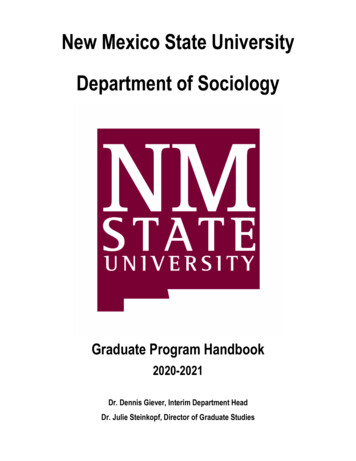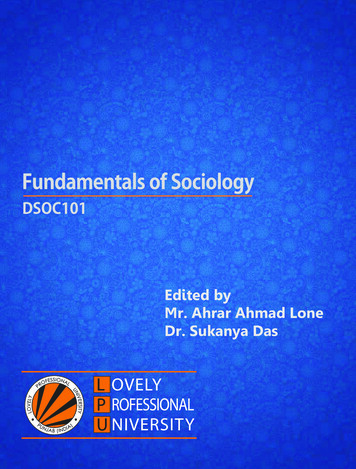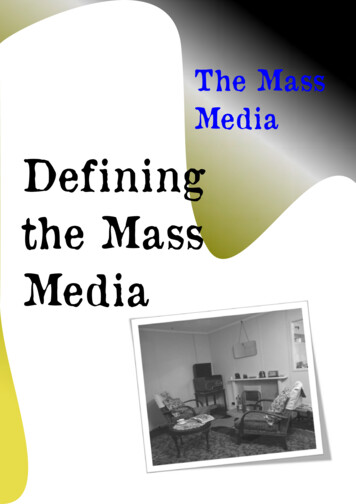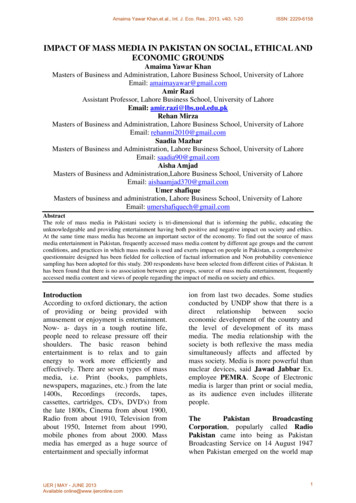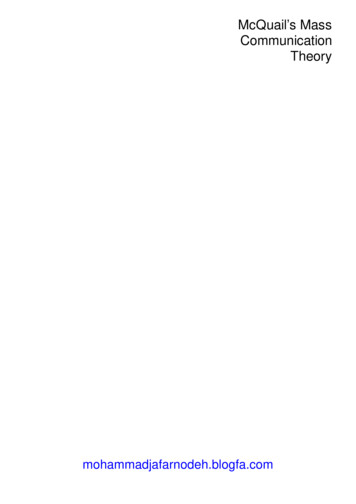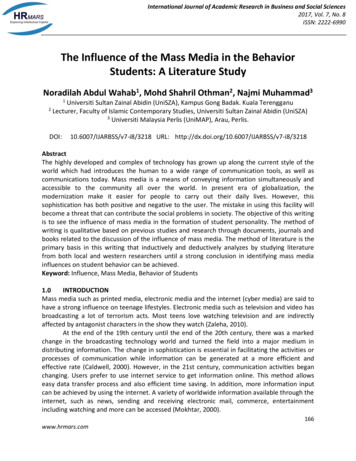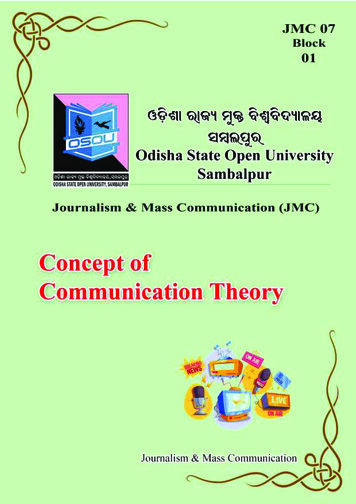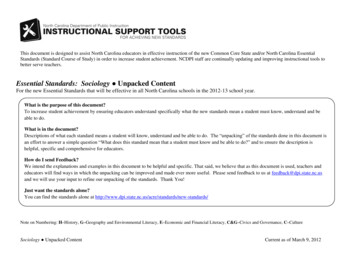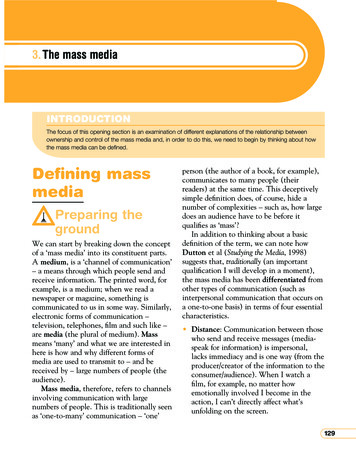
Transcription
3. The mass mediaINTRODUCTIONThe focus of this opening section is an examination of different explanations of the relationship betweenownership and control of the mass media and, in order to do this, we need to begin by thinking about howthe mass media can be defined.Defining massmediaPreparing thegroundWe can start by breaking down the conceptof a ‘mass media’ into its constituent parts.A medium, is a ‘channel of communication’– a means through which people send andreceive information. The printed word, forexample, is a medium; when we read anewspaper or magazine, something iscommunicated to us in some way. Similarly,electronic forms of communication –television, telephones, film and such like –are media (the plural of medium). Massmeans ‘many’ and what we are interested inhere is how and why different forms ofmedia are used to transmit to – and bereceived by – large numbers of people (theaudience).Mass media, therefore, refers to channelsinvolving communication with largenumbers of people. This is traditionally seenas ‘one-to-many’ communication – ‘one’person (the author of a book, for example),communicates to many people (theirreaders) at the same time. This deceptivelysimple definition does, of course, hide anumber of complexities – such as, how largedoes an audience have to be before itqualifies as ‘mass’?In addition to thinking about a basicdefinition of the term, we can note howDutton et al (Studying the Media, 1998)suggests that, traditionally (an importantqualification I will develop in a moment),the mass media has been differentiated fromother types of communication (such asinterpersonal communication that occurs ona one-to-one basis) in terms of four essentialcharacteristics. Distance: Communication between thosewho send and receive messages (mediaspeak for information) is impersonal,lacks immediacy and is one way (from theproducer/creator of the information to theconsumer/audience). When I watch afilm, for example, no matter howemotionally involved I become in theaction, I can’t directly affect what’sunfolding on the screen.129
AS Sociology for AQA Technology: Mass communicationrequires a vehicle, such as a televisionreceiver, a method of printing and soforth, that allows messages to be sent andreceived. Scale: One feature of a mass medium, aswe’ve noted, is it involves simultaneouscommunication with many people; forexample, as I sit in my living roomwatching Chelsea play ManchesterUnited on TV, the same behaviour isbeing reproduced in thousands of otherliving rooms across the country. Commodity: An interesting feature ofmass communication – in our society atleast – is that it comes at a price. I canwatch football on TV, for example, if Ican afford a television, a license fee (towatch BBC or ITV) or a subscription tosomething like Sky Sports if it’s onsatellite or cable.WARM UP: IDENTIFYING MASS MEDIAUsing the following table as a guide, inpairs or small groups, identify as manymedia as possible and decide (by ticking( ) or crossing ( ) the appropriate box)whether or not they qualify as a massmedium (of the ones I have identified,television does qualify but the telephone,for example, doesn’t).Digging deeperIn the above exercise, you will have found itreasonably easy to identify a range of massmedia. However, I suspect you will haveidentified some forms of communication(such as mobile phones and email) thatdon’t fit easily (if at all) into traditionaldefinitions, mainly because they have thecapacity to be both: interpersonal (‘one-to-one’)communication and mass (‘one-to-many’) communication.Depending on how it is used, for example,email can involve exchanging interpersonalmessages with friends and family (‘Hi, howare you?’) or sending one message to manythousands – potentially millions – of people;customers of on-line retailers, such asAmazon (www.amazon.co.uk), for example,can request email notification of specialoffers and so forth. Unrequested mass emails– commonly known as ‘Spam’ – also comeinto this category.In defining the mass media, therefore, wehave hit upon something that, as recently as25 years ago, wouldn’t have been a problem;namely, the development of computernetworks. The ability to link computertechnology (to create something like n Telephone Daily newspaper Mobile telephone Further media?130
The mass mediaInternet or mobile phone networks) hascreated a subtle – but incredibly important –change in the way we both define andconceptualise the mass media. To makematters even more complicated, computernetworks open up the potential for ‘manyto-many’ communication, where a massaudience can, simultaneously, interact andcommunicate with each other. In otherwords, a mass medium based oninterpersonal communication.To clarify this idea, think about thingslike: Internet chatrooms. These conform tothree of the components of a ‘massmedium’ identified above (technology,scale and commodity). However, the‘distance’ component is a problem. This isbecause, rather confusingly, a chatroomcan, simultaneously, involve one-to-one,one-to-many and many-to-manycommunication. Peer-to-peer networks involve usingsoftware to link individual computers,such that anyone connected to thenetwork can exchange informationdirectly with anyone else. In theworkplace, for example, this can meanany number of people can contribute tothe same piece of work at the same time.We can also note, however, this type ofnetwork can also be used to breechcopyright laws through the (illegal)sharing of music and films.ProducerConsumers‘Old’ forms of mass mediainvolve one-way communicationbetween a producer and a massaudience.way process of producers creatinginformation that is transmitted to largenumbers of consumers, and new mass media, such as peer-to-peernetworks, involving ‘many-to-many’communication based on two-waycommunication with participants asboth producers and consumers ofinformation.In the light of these developments, therefore,we need to redefine the concept of massmedia by creating a distinction between: old mass media, such as television, booksand magazines, that involve ‘one-tomany’ communication, based on a one-‘New’ forms of mass media can involve twoway communication within a mass audiencewho are both producers and consumers.131
AS Sociology for AQACrosbie (‘What Is New Media?’, 2002)argues that new (mass) media havecharacteristics that, when combined, makethem very different to other forms of massmedia. These include: Technology: They cannot existwithout the appropriate (computer)technology. Personalisation: Individualised messages(either tailored to the particular needs ofthose receiving them or having theappearance of being so constructed) canbe simultaneously delivered to vastnumbers of people. Collective control: Each person in anetwork has, potentially, the abilityto share, shape and change thecontent of the information beingexchanged.Crosbie uses the following example toillustrate this idea:Imagine visiting a newspaper website andseeing not just the bulletins and majorstories you wouldn’t have known about, butalso the rest of that edition customized toyour unique needs and interests. Ratherthan every reader seeing the same edition,each reader sees an edition simultaneouslyindividualized to their interests andgeneralized to their needs.132Ownership andcontrolPreparing thegroundThe distinction just drawn between old andnew media forms is important whenconsidering the relationship between mediaownership and control, since the old and newmedia involve potentially differentrelationships between owners, controllers,producers and consumers. To understand this,we need, initially, to define what we mean byowners These, as you might expect, are thepeople who own whatever medium in beingused to communicate information. We canidentify two basic types of media ownership. Private ownership, where companies areowned by individuals, families,shareholders and so forth. RupertMurdoch, for example, owns a controllinginterest in News Corporation, a companythat publishes books, films and magazinesand broadcasts satellite TV programmes,among many other things. State ownership: The BBC, for example,is state owned – it is funded by thetaxpayer and doesn’t have private ownersor shareholders. As an aside, however, wecan note there are different types of stateownership around the world. Insomewhere like China, for example, thegovernment directly controls mediacontent (the media is, in effect, staterun); the BBC, on the other hand, isoverseen by a Board of Governors who,although directly appointed by thegovernment, have a degree of
The mass mediaindependence from both the state anddirect political control.Ownership is significant here because ownershave the potential to decide what sort ofinformation an audience will be allowed toreceive. For example, private owners maydecide not to publish a book critical of theircompany, whereas state-owned companiesmay be subject to political control andcensorship over what they can broadcast orpublish.Controllers are the people who actuallyrun (or manage) a company on a day-to-daybasis – the editor of a newspaper or the headof a film studio, for example. Usually –especially when talking about very largemedia companies – managers are notoutright owners of the company for whichthey work (although they may own shares inthat company).Debates over the relative importance ofownership and control have traditionallybeen framed in terms of the significance of aseparation between ownership of, andmanagement roles within, media companiesto prevent, in Paul Mobbs’ (‘MediaRegulation and Convergence’, 2002) phrase‘Undue influence over, or bias in, content’.In other words, in this section we are goingto examine the extent to which there is aseparation between the roles of owners andmanagers (controllers) within the massmedia that, in turn, relates to debates aboutthe control of information.In basic terms, those writers who argueowners are the most significant players inthe media industry suggest they use theircontrol over information to show the worldin a particular light (one favourable to theirown particular viewpoint). On the otherhand, those who argue managers are mostsignificant are suggesting this creates adiversity of media involving different formsand sources of information, such thataudiences are able to pick and chooseinformation to suit their own particulartastes and, indeed, prejudices.Digging deeperWe can dig a little deeper into thebackground to this debate, prior toexamining some sociological explanations ofthe relationship between ownership andcontrol, by identifying and explaining anumber of significant ideas.Concentration of ownership refers to theidea that the ownership of various media(television, books and newspapers forexample) is increasingly restricted to arelatively small number of companies. Table3.1, for example, demonstrates this idea interms of the ownership of nationalnewspapers.In the wider global context, Nenova etal’s (‘Who Owns the Media?’, 2001)examination of media in 97 countries foundthat ‘almost universally the largest mediafirms are owned by the government or byprivate families’.The concentration of media ownership(on both a national and global scale) isimportant for a couple of reasons. Product diversity: If the number andrange of information sources is restricted,audiences increasingly come to depend ona small number of media corporations forthat information. However, since even interms of the above table, Britishconsumers have a choice of nine nationaldaily newspapers, the concentration ofownership doesn’t necessarily affect therange of products on offer (Table 3.1).133
AS Sociology for AQADaily Mail, Mail on SundayDaily Mail and General TrustDaily and Sunday Mirror, PeopleTrinity MirrorDaily Star, Daily and Sunday ExpressNorthern and ShellDaily and Sunday TelegraphTelegraph GroupGuardian, ObserverGuardian Media GroupIndependent, Independent on SundayIndependent NewspapersNews of the World, Sun, Times, Sunday TimesNews InternationalTable 3.1 English newspaper ownership 2003(Source: Department for Culture, Media and Sport)The question here, therefore, is, doesconcentration affect information diversity? Information diversity: RobertMcChesney (Rich Media, PoorDemocracy: Communication Politics inDubious Times, 2000), for example, argueswe have the ‘appearance of choice’ invarious media – lots of different productsall selling much the same sort of (limitedrange) of ideas. As he argues about MTV:‘it’s all a commercial. Sometimes it’s anadvert paid for by a company to sell aproduct. Sometimes a video for a musiccompany to sell music . . . Sometimes a setfilled with trendy clothes to sell a lookthat includes products on that set’. Compaine (‘Mergers, Divestitures and theInternet’, 2000), on the other hand,argues such an interpretation is mistaken– the global trend is not necessarily for anincreased concentration of mediacompanies. In addition, he argues mediaorganisations are not static entities – theydevelop, grow, evolve – and disappear.In ‘The Myths of Encroaching GlobalMedia Ownership’, 2001, for example, henotes how the dominant global mediacompanies in the 1980s were not134necessarily the dominant mediacompanies in the year 2000. For example,ten years ago Amazon.com didn’t exist. In2005 it’s one of the world’s largest mediaoutlets – will it still exist in 2015.Conglomeration is a second importantaspect of media ownership and involves theidea the same company may, through aprocess of diversification, develop interestsacross different media. For example, SilvioBerlusconi (the current Italian PrimeMinister), through his ownership ofFininvest, has a diverse range of mediainterests – television, book, newspaper andmagazine publishing and so forth. Oneimportant – and useful if you are a large,transnational company (one that operates ina number of countries) – aspect ofconglomeration is diagonal integration.Cross-media ownership can be used enhancethe profile and profits of different businesses.Rupert Murdoch, for example, usedownership of The Sun newspaper to promotehis satellite company Sky Broadcasting (latercalled BSkyB after it took over a competitorcompany) in its early years when it waslosing money. The Sun ran competitions towin satellite dishes and subscriptions, gave
The mass mediaSky and terrestrial (BBC and ITV)programme schedules equal space (eventhough Sky had a fraction of their audience)and publicised Sky through feature andentertainment stories.Murdoch also wanted to attractsubscribers by offering ‘first-run’ films beforethey were available to rent. However, toprotect cinema and rental markets,Hollywood Studios refused to allow TVcompanies to show their films until at leasttwo years after their initial release.Murdoch solved this ‘problem’ by buyinga film studio (20th Century Fox) to supplySky with films – which eventually forcedother studios to follow suit.In the next section (dealing with therelationship between the mass media andideology) we will pick up and develop theabove ideas in more detail, but to completethis section we can outline a number ofdifferent perspectives on the ownership andcontrol debate, starting with thosesuggesting ownership is most significant andending with those arguing the reverse – thatcontrol is most ing thegroundThis variation of Marxism takes a distinctposition on the relationship betweenownership and control of the media, basedon social class. An individual’s economicposition in society (their class) influencesthe way they see and experience the socialworld. For instrumental Marxists, society isseen in terms of a particular class structureinvolving a distinction between thebourgeoisie and proletariat (upper and lowerclasses). Those who own the means ofproduction (the bourgeoisie) are the mostpowerful and influential grouping in anysociety and they try to keep their powerfulposition through their ownership andcontrol of ideological institutions. Culturalinstitutions, such as the media, are used as atool (or instrument) to spread ideasfavourable to the bourgeoisie throughoutsociety. Writers such as Milliband (The StateIn Capitalist Society, 1973), argue the rulingclass has a common economic status (asowners and controllers – people who aregenerally drawn from the same social class)and cultural background, created andreinforced through education (publicschools, Oxford and Cambridge Universitiesetc.), family networks, interlockingdirectorships (where the same person is adirector of numerous different companies),media ownership and so forth. Scott(National Patterns of Corporate Power, 1991)for example, noted the significance of banksand insurance companies in the USA andEurope as centres of corporate networksthrough which businesses develop and arecontrolled.Digging deeperFrom this perspective the relationshipbetween ownership and control of the mediais straightforward. Owners have ultimate control over acompany – they decide, for example, whoto employ to run their businesses. Managers only ‘control’ a business (such135
AS Sociology for AQAas a newspaper) in the sense they overseeits operation. The editor of a newspapermay control things like the storiesappearing each day, the hiring and firingof employees and so forth. The owner,however, ultimately controls the politicalstance of the paper, the type of audienceit aims to reach and the like.Ownership and control, therefore, needs tobe seen as part of the same process, whichhas two, interconnected, objectives. Economic: One objective, you probablywon’t be too surprised to learn, is usuallyto make profits. However, a second (insome cases more important) objective is: Ideological, in the sense of trying tocontrol how people see the social world.This aspect is significant because it isdesigned to create the conditions underwhich profit is not only created – andkept in private hands – but is seen aslegitimate (‘right and proper’). In otherwords one objective, common to bothowners and controllers, is to protect andenhance the interests of a capitalist rulingGrowing it yourself: editorial control?Identify some of the ways owners try to ensure employees reflect their views (the followingextracts may give you some ideas to get you thinking).Investigating the Media (1991), Paul TrowlerThe following was cut from Trowler’s book (for HarperCollins – owned by News Corporation)Source: tm#murdochMurdoch is well known for intervening in editorial policy. He sacked Harold Evans, editor ofThe Times, after disagreements over policy. Frank Giles, former editor of the Sunday Times,said Murdoch would make a point of dropping into his office just to check on the first copiesof the paper. Fred Emery, home editor of the Times in 1982 reported Murdoch as saying ‘Igive instructions to my editors all round the world, why shouldn’t I in London?’.‘Patten and Murdoch Quarrel – David and Goliath Again?’ (1998) Terry BoardmanWorried that Patten’s criticisms of China in his forthcoming book ‘East and West – The lastGovernor of Hong Kong’ would upset Beijing and thus spoil the strenuous efforts he had beenmaking to reingratiate himself with the Chinese . . . Murdoch, with his current audience of 36million Chinese viewers and a potential further 240 million in mind, promptly orderedHarperCollins to drop the book.‘Newland Unleashed’, The Guardian: 15/11/04‘Black [the ex-owner of the Daily Telegraph] is not there anymore, the new owners do notinterfere, it is basically down to us in a way it hasn’t been for many years’ . . . The Barclays [thenew owners of The Telegraph], he says, have not laid down a clear political line. ‘There are stilloccasional conversations. I might call about something. Normal, friendly, conversations’.Examples: Hiring people who reflect owner’s views. Not hiring journalists who don’t reflect the owner’s views.136
The mass mediaclass and this is achieved, according toinstrumental Marxists, through themedia. Because the media is a majorsource of information about society it isused as a tool (or instrument) throughwhich ideas, beliefs and behaviours aremanipulated. Ownership and control,therefore, is used to create a picture of thesocial world beneficial to the interests ofDiscussionquestions:evaluating thisperspectiveTo help you reflect critically about thisperspective, think about and discuss thefollowing questions. Conspiracy theory: Does this perspective develop a conspiratorial viewof the media and the role of owners?Why do some parts of the media criticisethe activities of powerful individuals,companies and governments?Ruling class: Do all members of thebourgeoisie have the same interestsand, if so, what are they and how domedia owners know what they are?Choice: In terms of old media there is arange of choices available, givingaudiences access to different viewpoints;many people also have access to a widerange of new media. How easy is it for aruling class to control the way peoplethink when such choices are available?Audience: Are media consumers simplypassive recipients of whatever ownerswant to publish, or are they moresophisticated and reflecting? Are someparts of the media audience (such aschildren) more open to influence thanothers?the most powerful people in society – anda key idea here is false consciousness. Bytheir ability to control and limit theinformation people receive, a ruling classis able to control how people think –both directly and indirectly – about thethings happening in society.An example of false consciousness can bedemonstrated with respect to the war inIraq. From this perspective people weremanipulated into supporting the war on thebasis of Iraq having ‘weapons of massdestruction’ (which, we were repeatedlyinformed, could be used to launch an attack‘within 45 minutes’). We will return to thisidea when, in the next section, we look atthe relationship between the media andideology in more detail.Neo(hegemonic)MarxismPreparing thegroundNeo-Marxists such E.O.Wright (Classes,1985) take a different approach to theirtraditional counterparts and, initially, themain points to note relating to thisperspective are: Social class is not a static (unchanging)classification system; rather, it’s seen (orconceptualised if you prefer) as a dynamicsystem of shifting and changing socialrelationships. This suggests: Conflict, divisions and contradictionsoccur within a dominant (or ruling) class.137
AS Sociology for AQAA simple example here might be to notehow some parts of the bourgeoisie in oursociety are pro-Europe while others areanti-Europe. Class associations can involve ethnicand gender dimensions (for example,individuals from some ethnic groups maybe economically successful while seeingthemselves, culturally, as not belonging toa middle or upper class). Professionals and intellectuals (theupper middle classes) have significantroles in the class structure. They occupy,according to Poulantzas (1975),‘contradictory class positions’ – neitherwholly bourgeois nor wholly proletarian.This, for neo-Marxists, is a significantidea in any explanation of therelationship between media owners andcontrollers. Owners have to make profits – this istheir guiding principle (since if businessesare unprofitable they may cease to exist). Managers also see profitability asimportant, since their jobs, salaries andlifestyles depend on it. social structures – the web of socialrelationships surrounding us and consciousness – people’s ability tointerpret behaviour in many differentways.In other words, both owners and controllershave a basic common interest that binds themtogether, expressed in terms of core values.They are likely to share, for example, beliefsabout the importance of profits, which inturn presupposes a (fundamental) belief incapitalist economic systems. Marginaldisagreements may occur between thesegroups over such things as the most efficientway to make profits, but not over the basicprinciple of the need for profitability.Although media owners and professionalsshare a common cause in promoting andpreserving certain basic values this doesn’tnecessarily mean – as we have just noted –they will always agree on the best way topromote and preserve such values. From thisperspective, managers enjoy relativeautonomy (a certain amount of freedom tomake decisions). Transnational mediacompanies, for example, are too large andcomplex to be easily controlled by a singleowner/board of owners on a day-to-day basis.They employ people (managers) who can betrusted to:They argue this is an important distinctionbecause it is impossible for any individual(let alone a very large group such as a rulingclass) to directly control how people thinkand behave (the ‘conspiracy aspect’ oftraditional Marxism). Rather, they use theconcept of hegemony to show how bothowners and controllers are locked into a(structural) relationship that is, in one sense,mutually beneficial. Reflect their views: Editors who insist onignoring the policies laid down by theiremployers are likely to find themselvesunemployed, unless they: Make profits: As long as it is legal (andsometimes if it is not) the key principle isprofitability – some modern media ownersmay not care too much about thebehaviour and activities of their managersas long as the money continues to roll in.Digging deeperIn developing the above ideas we can notehow neo-Marxists stress the distinctionbetween:138
The mass mediaDiscussionquestions:evaluating thisperspectiveTo help you reflect critically about thisperspective, think about and discuss thefollowing questions. Owners: Is the significance of their role exaggerated? For example, many mediacompanies are owned by large pensionfunds, making the role of managersmore significant (the only interest apension fund has in the running of acompany is whether or not it produces agood return on investment).New media: How do things like theInternet fit into this equation? If peoplecan effectively ‘search the globe’ forinformation, does this make questions ofmedia ownership and control irrelevant?PluralismPreparing thegroundAn alternative way of looking at therelationship between ownership and controlis a framework that stresses how socialgroups compete against each other in theeconomic market place. For example, twotypes of group we could note are: interest groups, an example of which mightbe a business (such as a publishing company)pursuing some economic or social objective status groups, for example, a Trade Unionpublishing information specific to themembers of a particular occupation. Oneaspect of the Union’s role might be topromote and enhance the reputation(status) of its membership.From this perspective, societies involvegroups pursuing their own (sectional)interests and, in so doing, they create: explicit competition involving, forexample, different newspaper groupscompeting for readers implicit competition involving politicalgroups promoting different economic,political or cultural views they wantreflected in the media.For pluralists, competition is based on thedesire for power, which can, for example, beexpressed in terms of: economic power – such as making profitsor gaining market share political power – such as influencingdecisions made by governments.Digging deeperMedia owners are clearly powerful players inany society since they are in a position tohave their views heard. However, Pluralistsargue those who control the day-to-dayrunning of the media are also powerful, for acouple of reasons. Modern (‘joint-stock’)media companies tend to be owned by groupsof shareholders rather than by all-powerfulindividuals. John Burnham (The ManagerialRevolution, 1943), for example, argued that,where no single shareholder had overallcontrol of a business, this meant directorsand managers were the main policy-makers.Thus, the day-to-day running of a businesswas in the hands of a technocraticmanagerial elite – people whose job it was torun a business in the best interests of theshareholders. This is a powerful group,139
AS Sociology for AQAaccording to pluralists, because their jobdepends on knowing what an audience wantsand being able to provide it.To survive, a business must competesuccessfully in a market place which meansconsumers (the people who buy the productbeing sold – or not as the case may be)influence the behaviour of an organisation:if consumers don’t like – or moreimportantly buy – what’s on offer the sellereither improves or changes their product orthey go out of business.For pluralists, the private ownership ofthe media is significant because it promotesDiscussion questions: evaluating thisperspectiveTo help you reflect critically about this perspective, think about and discuss the followingquestions. Murdock and Golding (‘Capitalism, Communication and Class Relations’, 1977) argue Pluralists overstate the distinction between owners and managers – do you think theinterests of these two groups really are as separate as Pluralists claim? Although ownersmay not personally oversee the content of the media they own, how likely is an owner toemploy managers opposed to their social and economic interests?Shareholding: Are individual owners more powerful than pluralists suggest? Althoughmodern companies may have many shareholders, it’s still possible for individuals to controla business. Rupert Murdoch, for example, has a 35% share in News Corporation, giving himcontrol over the company. As James Curren (‘Global Media Concentration’, 2000), notes:The power potentially at the disposal of media owners tends to be exerted in a onesided way . . . this power is qualified and constrained in many ways – by . . . consumersand staff, the suppliers of news, regulators, rival producers, the wider cultural patternsof society. But it is simply naïve to imagine that it does not exist. Old and new media: Alth
Defining mass media Preparing the ground We can start by breaking down the concept of a ‘mass media’ into its constituent parts. A medium, is a ‘channel of commun

